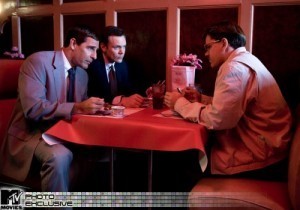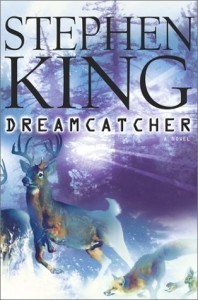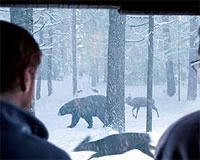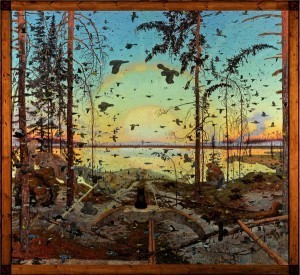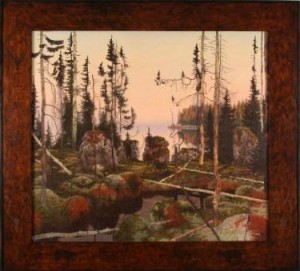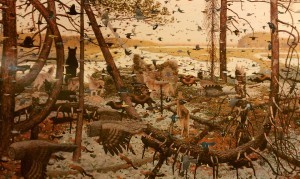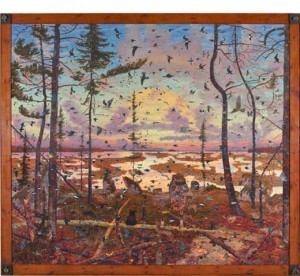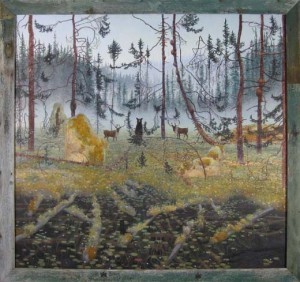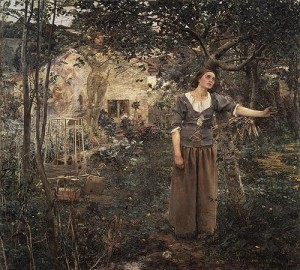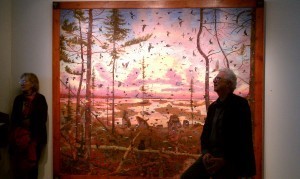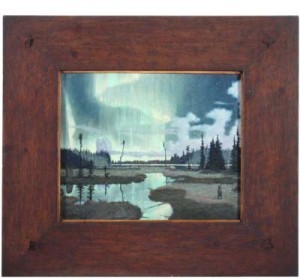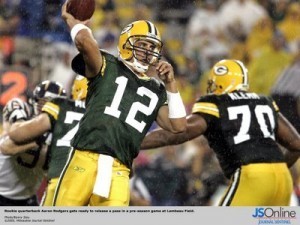Ilsa J. Bick's Blog, page 39
March 6, 2011
February 2011 Reads, Listens and Looks
It's shocking how much flies by when I'm deep in writing-mode. Considering that I always seem to be writing something, I guess that means a lot slips on by because, really, the writing comes first, even before feeding my husband. The cats, I never forget, but since they're around all the time, that's not bloody likely anyway.
Which is all by way of saying: yes, I'm late. AGAIN. I get ticked off about that. It's not one of those oh-but-I-didn't-have-time deals. Everyone has the same 24 hours I do. It's that I chose to focus on banging out pages rather than taking a day off to do the blog. But intense write-mode also means that I had less time I wanted to take off to read (and listen and look)–and a little less patience, too. If the book didn't grab me by the first 40 pages or so, I just put it down and moved on. The number of books I actually read all the way through was shockingly few this past month–and one book, that was quite intriguing, I'm not going to recommend because there were enough problems that I just can't say, oh boy, you got to read this. There was some stunning writing and a nifty situation/setup . . . but, also, a lot of false notes. So, better to say nothing at all.
Similarly, there were quite a few bestsellers in the mix that, again, I kind of went wuh? So they're not here either.
I also have a few more movie recs than usual, mainly because I watch movies as I exercise. Passes the time and I get to catch up on shows and movies that slipped by when I was, well, in writer-mode. (See? I told you: it's all the bloody time.)
Oh, and one more thing: You'll notice that, whenever possible, I list the book through IndieBound instead of Amazon. Because, you know, we ALL know that you can find anything on Amazon, but brick and mortar bookstores are important, folks. Yeah, yeah, readers are nice and convenient, and it's great when the UPS guy brings you that little Amazon box, but there is NOTHING quite as nice as a good, slow browse that gives you the time to appreciate all the work and thought that went into the entire package, from that eye-catching cover to the font. And you get to skip around to the middle of the book and see if you're still as intrigued by the writing as you were by that first sentence and paragraph. Just saying . . .
So let's get on it.
READS
Beaufrand, Mary Jane; The River (Little, Brown and Company; 2010). I try to read books that are up for awards, and this YA mystery's in the running for an Edgar this year. Set in rural Oregon, this story revolves around the mysterious death of a little girl and her older friend's attempts to both solve and come to terms with her death. I found this story to be very engaging, but the skilled and/or veteran reader will figure this out in three seconds and there are a few sections–all the river-is-talking stuff–that are simply unnecessary. Similarly, the end was kind of . . . well, a head-scratcher if only because abandoning the world that Beaufrand so carefully constructed seemed like a cop-out. So that's not the reason to read this. What Beaufrand does very well is setting (as in where you are) and developing a very nice set of supporting characters. I found the parents in this story–with all their foibles and problems–to be particularly well-done. I don't know if this will win or not, but it's really a nice read and deserves your time.
Gray, Melissa; All Cakes Considered (Chronicle Books; 2009). A cookbook. Ilsa, are you serious? Uh, yeah. See, I love cooking; I love cookbooks. Cooking is how I relax after a hard day pounding that keyboard. Sometimes, when I'm in intense writer-mode, we eat crap. Most of the time, though, I try to put some care into dinner because it's the only time I see my husband and–honestly–there are so many interesting cuisines out there. Plus, I live in rural Wisconsin, which means that if I want bim-bim-bap, I got to figure out how to make it myself. So I've got a book of medieval recipes as well as Greek, Roman, Korean, a couple Indian, the obligatory Moosewoods . . . all that stuff. Cooking is fun and an adventure and, for me, largely impressionistic. Sure, I follow recipes, but they tend to be a little forgiving.
Baking is another story. I'm always a little intimidated because so many recipes seem so precise. And, truthfully, I'm not that much of a dessert fan. Just never developed a taste for it, although I do like cake. But then there are only so many places to spread those calories, you know?
For the book I just finished, though, a cake was important. So I had to figure out how you might be able to bake one without an oven-oven. That led to all kinds of research, including this cookbook I picked up at Mount Vernon. See, Martha Washington used to make this immense Great Cake, this fabulous Christmas cake with eggs and butter and all sorts of fruit and nuts . . . anyway, I thought, wow, I got to make that someday. So far, I've made a couple of the steamed pudding recipes (love persimmons) but never attempted the cake. But I pulled the book out again while writing–and thought, hunh, I got to read a good book on baking, period, something that tells me why I need to cream butter at room temperature and all that. Just curiosity.
So I happened on Gray's book–and it's great. Not only that, I discovered that Gray had the same idea I did: bake Martha's cake (and she includes the recipe in the book). There are over 50 recipes here so you go from easy pound cakes to more complicated layer cakes, with some fun cookies and things like that thrown in for good measure. So, want to do a kind of low-key Julia Child thingamabob? Bake a cake a week, which is what Gray did (and still does) for her NPR pals.
MacCready, Robin Marrow; Buried (Dutton Juvenile; 2006). Okay, so having looked at one Edgar nominee, I went back and re-read this Edgar winner. I remember the first time I read this story about a high school senior's pretty creepy disintegration after her alcoholic mother disappears, and I feel the same way now as I did then: like, shoot, why didn't I think of that? (Okay, I used stronger language.) I had the ugly green envies for a week. This is a fabulously well-done psychological mystery that manages to be both highly believable and genuinely weird–because, really, self-deception is what this book is all about. As a shrink, I've heard and seen some pretty out-there stuff, and this rang true for me throughout. A highly satisfying read that deserved its award. Give it a shot.
Reinhardt, Dana; The Things a Brother Knows (Wendy Lamb Books; 2010). The premise here is pretty interesting: older brother goes off to war; comes back to his family; acts pretty weird and withdrawn, leaving his younger brother to wonder whatever happened to the guy he admired. Now, this is a setup for a descent into caricature. It's to Reinhardt's credit that this book doesn't–and what makes it a standout is the added twist that the dad in this story is Israeli. The grand-dad's Israeli. Mom's American but would happily have stayed in Israel for the duration, but the dad wanted to come to the U.S. and have a better life than he might have hanging around a kibbutz.
Now why is this important? Because military service is mandatory in Israel. Everyone does it, girls and boys. This is a country surrounded by enemies after all, most of whom would be happy to wipe Israel off the map. So the military is not the foreign animal it is for a lot of people in the U.S. who don't serve, or know no one who has served, or even care. What Reinhardt does here, very well, is present a picture of a family coping with the aftermath of a soldier dealing with the aftermath of war. That alone is worth the read. I have to admit that the book is a little clunky; there's a lot of exposition and repetition, but once the kid and his brother hit the road (the brother won't get in a car and walks to D.C.–from New York), this book picks up speed. The end wasn't all that shocking or revelatory; you can see it coming a mile off. But that's not the issue here. This is a story about growth and a journey toward self-awareness and empathy for others. It's a fast read and worth the time.
LISTENS
Sadly, I had time for only one listen this month, but it was great.
Koontz, Dean; Strange Highways (Time Warner AudioBooks; 1995); narrated by James Spader. Okay, listener be warned: these are cassettes (four of them) and all you'll get from this volume of early Koontz is the title story. But, boy, it's a doozy. I'll be honest; I chose this because I love James Spader as an actor and think he's got a fabulous voice. He can read the phone book as far as I'm concerned. He does a great job with this story and that's a good thing because this is not one of Koontz's best (in terms of actual writing). This is an extremely early work (I believe he wrote this when he was about 20) and a bit clunky, with unnecessary detail. Spader's narration makes that a lot easier to get through; I suspect if I had to read this, I'd be skimming big chunks. Nevertheless, this eerie tale of second chances, fraught with religious mysticism, is very good; you can see that, from very early on in his career, Koontz has been focused on themes to which he'll return time and again. After listening to this, try Velocity next; also a worthy listen.
LOOKS
The Ghost Writer (Roman Polanski; 2010). Based on Robert Harris's The Ghost (retitled The Ghost Writer after the movie's release), this stylish mystery follows an unnamed professional writer who's called in to "ghost" for another writer in the middle of ghosting the memoirs of a British PM. With me so far? So the first writer dies in a mysterious accident. The second ghost begins to suspect the first writer was murdered and struggles to figure out why before he's summarily dispatched, too. This fine movie stars Ewan MacGregor as The Ghost and Pierce Brosnan in a great turn as the cynical British PM (clearly modeled after Tony Blair). Hitchcock's influence here is evident throughout, from the music to the situation. Great fun, very involving and the end evokes the gut-punch of Vertigo while being so very Polanski (think Chinatown).
The Talented Mr. Ripley (Anthony Minghella; 1999). Gosh, who knew Minghella could direct AND write great screenplays? I didn't, until I realized that this guy directed some of my favorite films. This fabulous Matt Damon movie about a chameleon-like, highly charming sociopath also features a superb supporting cast in Jude Law, Cate Blanchett, Phillip Seymour Hoffman and Gwyneth Paltrow (when she was actually making decent movies). Based on the 1955 book by Patricia Highsmith, this is also a wonderful meditation on class distinction and homosexuality. That final sequence is just . . . wow, what a great shot.
Toy Story 3 (Lee Unkrich; 2010). I love these films. This (likely) final installment in the series revolves around Andy's imminent departure for college and the toys facing up to their own obsolescence. Really, where do toys go and what happens to them when kids no longer wish to play with them? This film about loss and separation–about knowing when it's time to let go–made me want to run home and find the few old stuffed animals I have from when I was a kid and give them a hug–just for old time's sake.
February 20, 2011
When I Grow Up . . .
I want to own a stinging red car. I have always wanted to own a stinging red car. A story I wrote and which the most wonderful Ellen Datlow bought for SCIFICTION when SCIFI was SCIFI and not SyFy (about whose meaning I, frankly, don't have a clue unless this is supposed to contribute to the current wave of dumbing things down to very lowest common denominator) was entitled "The Woman in the Cherry Red Convertible by the Platinum Sea." A mouthful, but a cool story (if I do say so myself) and fun because I got to indulge in a bit of car-color fetishism.
Perhaps my obsession with owning a red car explains some aspects of my car envy. When Maggie Stiefvater showed off proud photos of her Loki painted a brilliantly wonderful red, I went into conniptions.
Because you must understand: I live in Wisconsin. We are decidedly subdued. We don't call attention to ourselves. I'm not Lutheran, but this is Lutheran country and everything Garrison Keillor says is the G-d's truth, even quivering Jell-O molds with fruit cocktail which, I must admit, my mother made when I was a kid (although she was originally Greek Orthodox, so go figure).
Anyway, I decided that the next car I bought would be red. Period. End of story.
So, today, I brought home my baby: a lovely Nissan Xterra 6-speed, manual, because we all know that sticks are wonderful to drive, blah, blah.
 Now, is this the sexiest car? Of course not. Does it drive like a truck-truck? Yes. Is it, in fact, a truck cleverly disguised as an SUV? Pretty darned close. Will it push the snow plow so we can get out of the driveway and was this only one of two vehicles that could handle the plow AND came as sticks? Yes. (The other was a FJ Cruiser–decidedly retro but drove like a Brinks armored car. All I needed was a Pinkerton detective riding shotgun. And talk about claustrophobia . . . teeny, tiny windows that doubled as gun-ports.)
Now, is this the sexiest car? Of course not. Does it drive like a truck-truck? Yes. Is it, in fact, a truck cleverly disguised as an SUV? Pretty darned close. Will it push the snow plow so we can get out of the driveway and was this only one of two vehicles that could handle the plow AND came as sticks? Yes. (The other was a FJ Cruiser–decidedly retro but drove like a Brinks armored car. All I needed was a Pinkerton detective riding shotgun. And talk about claustrophobia . . . teeny, tiny windows that doubled as gun-ports.)
But, believe it or not, this is not a post about my Nissan. You know, cars are cool, but they're just cars. (I know: sacrilege.) No, no, this is about what you can learn from watching television.
I just so happened to have stumbled on a fabulous show, "Men of a Certain Age." The New York Times turned me on to it after doing not one but two great reviews, and I have to admit that I rented the first season from Netflix because I was curious to see what Scott Bakula was up to after Enterprise.
(Is Bakula my favorite actor? No. Did I like Quantum Leap? Yes, but I wasn't devoted. Did I watch Enterprise? Not often, and I'm a Trekker. The show just never floated my boat. Still, I was curious and he was fabulous in The Informant! which was an overall great film with Matt Damon playing the anti-Bourne.)
Well, first of all, the show's great. If you've never seen it, you can catch Season One on DVD; the second season just wrapped up on TNT although the show will return for the summer. No, I haven't watched any of those episodes; I was too busy watching Season One and getting thoroughly hooked.
What's it about? Pretty simple, actually: the show revolves around three best friends, all guys around 50, all of whom are in some stage of midlife crisis. Ray Romano is Joe, who owns a party supply store, is separated from his wife and two kids, and has a gambling addiction.
Andre Braugher is Owen, a happily married guy with three kids who's unhappily employed as a car salesman for his father's Chevy dealership.
And Scott Bakula, he of Captain Archer fame, is Terry, a failed actor with a Peter Pan complex and, except for his two friends, a pretty empty life.
Anything I can say about the show has already been said better and more coherently by the reviewers for the New York Times–so all I can add is a resounding YES: this is not a show for guys. It's for us girls who believe that guys really have these soulful conversations about life, the universe and everything. The reality is … probably not. But it's still great to watch.
And educational, too. I'm referring specifically to the ins and outs of car dealerships. Now, do I take everything I see on television as the G-d's truth? Of course not. But was it, well, fascinating to see a scenario I watched on TV played out as my husband and I were going through the paperwork for the car? Oh, yeah. If I hadn't just watched it happen in fiction, I'd never have believed it.
What I'm talking about are the tactics to make you shell out more money–specifically, the parade of people who not only congratulate you on making such a fine purchase but then play off one another to try and get you to pay more. Now, we didn't haggle; it's not my style and I knew what I wanted and so it was . . . fine, let's just do this, I have books to write. But there was an episode in MoaCA, "How to Be an All-Star," that could've been our experience in Spark Notes: the salesmen going through all sorts of machinations–enlisting fellow salesmen to act as bogus experts or play off one another to corral a buyer into paying more or closing a deal–that I pretty much lived through. Nothing quite so silly as different salesmen pretending to be IT experts, but close. For example, there wasn't much to wrangle about with our car; we special-ordered it because no one in America seems to want a stick anymore and we knew what we wanted. There just wasn't that much left to try and sell us on; we'd already done the research.
But there were a few little extras: coverages for this and that and, the priciest: a hefty protection package that would, essentially, Scotch-guard the entire bloody car, inside and out. We were quoted one price. Then, in the business manager's office, we were quoted a different, lower price, one that was "at cost." When we still didn't bite (it was only a hundred bucks lower, for heaven's sake) and when the deal was nearly done, the big overall manager–actually, a very nice guy–appeared to tell us that he'd give us a $500 rebate if we buy the service RIGHT NOW and at this ONE TIME PRICE.
So, magically, in the space of fifteen minutes, we're down to half the original quote.
You have to visualize it: us, the business manager, the big dealership manager, the guy in the office next door who's looking through the window . . . all of them teaming up to try and make us buy this package.
I kept looking around for Andre Braugher. It was like I'd wandered onto the set of the show because this was EXACTLY what those guys did.
No, we didn't buy the package. The dealership manager then cornered us at the door, asking what it would take to get us to bring the car for service. We live an hour away, so it's just not feasible and there's a smaller dealership nearby–who, yes, treated us badly in terms of the sales and explains why we didn't buy from them but who can, yes, service the car.
The thing is, I felt bad saying no to the guy. I felt bad declining his offer to knock down the price of the protection package. If I'd been alone, I might have caved; the husband is a wonderful reality check in these kinds of situations.
But what this means is that the television show has it spot on.
Now, should you run and watch this show so you know how to behave in a car dealership and what machinations the sales force goes through to get you to cough up more cash? No. But does television sometimes get it right AND manage to create a fabulously fun (though not funny) and addictive show to boot?
Oh, you betcha.
I'm going out to take mah truck for a spin.
February 13, 2011
Portrait of an Artist
In Stephen King's Dreamcatcher, there's a scene where all the wildlife is streaming through the woods, trying to escape from the aliens. A lot of stuff happens before and after, but that's one scene I've always remembered, both from the book (whose first cover I do believe referenced that) and the movie.
I thought of King's book three years later–seven years ago now–when I had the great good fortune to wander into the Milwaukee Art Museum for an exhibition of a Wisconsin painter I'd never heard of. His name (then and now) is Tom Uttech, and the exhibition, Magnetic North, was a real eye-opener. Tom was deep into what people have called his "migration" paintings which, to hear him talk about them, is as good a word as any: short and somewhat descriptive. Tom's migration paintings are like that: all kinds of animals fleeing from some unseen danger, some painted on these HUGE canvases. These paintings are stylized, brooding masterpieces, full of menace and frenzy. Those animals are running and flying away from something really bad–and the danger spills out of the paintings onto the frames which Tom makes by hand for each painting, incorporating elements that both further and complement the painting. Of course, not all his paintings are like this; there are just as many paintings that are quiet and contemplative. But I really responded to the menace in these. This artist is a genius.
Tom Uttech, Enassamishhinjijweian, 2009. Oil on linen, 103 x 112 in. © Tom Uttech; Alexandre Gallery, New York.
Tom Uttech, Enassamiian, 2009. Oil on linen, 33 x 36 3/8 in. © Tom Uttech
Tom Uttech, Detail from Nind Awatchige, 2003. Oil on linen, 112 X 122 in.; © Tom Uttech; New Orleans Museum of Art
Since I've been a Tom Uttech fan-girl for a while now, I was thrilled to attend a new exhibition of his work, Boreal Conversations, at the Tory Folliard Gallery here in Milwaukee. (Tory's gallery and the Alexandre in New York are the only places where Tom's work can be had.) Tom's work has really evolved, and while he still had one big migration painting on display (going to the Chassen; lucky dogs)
Tom Uttech, Nin Mamakadendam, Oil on Linen, 91 x 103″ in. © Tom Uttech; Collection of the Chazen Museum of Art, University of Wisconsin-Madison
the majority of his work is much quieter now and more contemplative. Some pieces still have a lot of mystery to them, but these works invite you to immerse yourself in something mystical rather than wonder about what's off the canvas. In fact, this painting
Tom Uttech; Makwa Pindig-Wabashkiki, Oil on Linen, 66 1/2 x 71 1/2″ in. © Tom Uttech
reminds me of this painting by LaPage:
Jules Bastien-Lepage, Joan of Arc, 1879; Oil on canvas; 100 x 110 in; New York: The Metropolitan Museum of Art
Why? Beats the hell out of me. I'm sure it has something to do with the coloration . . . and a lot to do with mystery.
Tom gave a fabulous talk, and it was really interesting for me as a writer to hear that Tom feels the same way about his work as I do about mine: that, half the time, he's making a real mess of things.
I actually felt relieved to hear how an artist I really admire sometimes HATES what he's doing, only to find his way to doing something he's ultimately proud of. Just about every writer I know–me, included–feels the same way right around the dreaded middle third of every book. I'm there right now with the ASHES sequel (and, as Tom pointed out, thank G-d for deadlines, imposed either by yourself or someone else; I put a deadline on everything I write or else I'd never stop tinkering). It was also fascinating to hear Tom talk about the importance of structure in trying to get across whatever story he's painting; in a way, Tom's focus on where to place a tree, how to direct the eye is the same as figuring out how to pace a book or move people around in a scene.
But what was really fascinating was to find out that Tom hides things in his paintings. Some things are there to be found–like the Ojibwe trickster Maymayguishi or various animals (there's a very early triptych of his at hanging in the bar at Blackwolf Run here in Kohler, and the challenge is to find all the animals hidden in the landscape). But others are known only to Tom; he talked about how he included woolly mammoths and flocks of passenger pigeons in that painting he did for the Chassen . . . and then covered them over. He knows where they are, but we don't. I think this has something to do with what Tom wants to inspire in anyone who views his work. He invites you to wonder about presence, whether that's the presence of a wolf crossing the landscape at this very minute, or the bird that flew over that lake ten or a thousand years ago.
This fascination with mystery extends to the names he gives his paintings. They're all Native American (largely Ojibwe) and while some reference real places on a map, none ARE real in that sense. But Tom is interested in origins, and the names he gives his paintings reflect his reverence for the original language as much as they do the land where man has no place. There are, in fact, no people in his paintings at all, although he will often use a bear as a human stand-in. Look for the teeny, weeny, eensy bear in this:
Tom Uttech, Nind Agotagos, 2010, Oil on Museum Board, 16 1/2 x 18 1/2″ in. © Tom Uttech
So if you're in Milwaukee or New York in the coming months, give Tom a look-see. Keep an eye out for his shows–and, as friend of mine once said, prepare to get your mind blown.
What'll make this girl happy? An Ilsa Bick book with a Tom Uttech cover. Right . . . dream on.
******
Apropos of absolutely nothing, here is a fabulously funny recut trailer for The Shining. Thanks to my daughter for shooting this my way:
February 7, 2011
You Know You're a Fan When . . .
You're thinking this might be kinda cool . . .
Fans flock to Lambeau: fox11online.com
I think I'll go lie down and wait for that to go away . . .
February 6, 2011
January 2011 Recommended Reads, Listens and Looks
While I read several books this past month, only a couple were standouts. I also indulged in some short stories–something I don't normally do because I'm so focused on writing novels–and was just blown away by a couple, which were just splendid. Unfortunately, I listened to very little but caught up on a couple favorite movies and one currently in theaters that's . . . well, I wish I'd written it.
Without further ado:
READS
Allen, Nina; "Wilkolak", Ghosts: Crimewave #11 (TTA Press; 2010). As I announced on my blog, I was pleased as punch to be included in this fabulous British publication and even more tickled when I got a gander at the company I'm keeping. This story about a young man, his camera, and a fatal obsession with murder was a bit long but more than delivered. Although the final revelation–the identity of the murderer–was not a surprise, the skill with which this was delivered was simply fabulous, and the last line was a sucker-punch to gut. Just breath-taking–and Andy Cox, the editor, deserves a medal. Or an award. SOMETHING.
De Noux, O'Neil; "K Love" , Ghosts: Crimewave #11 (TTA Press, 2010). A suicide note in a clear plastic sandwich bag, a grisly crime, and a female detective working in post-Katrina New Orleans, while another storm, Rita, threatens . . . this intense and effective story within a story had me from the first line. The little touch of humor at the end just added to the overall grimness of the tale. Nicely done.
Donnelly, Jennifer; Revolution (Deckle Edge, 2010). Okay, I'll say right now that I very nearly passed this book by. The premise was intriguing–the intertwining stories of a suicidally depressed, modern-day teenager and a young woman, the companion of a doomed prince, caught up in the heady days of the French Revolution. But while I know a fair amount about music, most of my experience lies in the classical repertoire. This story's many references to contemporary music were a little tedious and felt unnecessary–but then again, I'm not the target audience. Some of the plotting was a bit clunky: the discovery of the diary, for example, and the time travel just didn't work. While the historical research that went into this book was impressive, Alexandrine's voice was less than authentic (for her social status and educational level, her language was much too cultured). Still, the basic premise is compelling: whatever the era, love can be redemptive.
Lanyon, Josh; "The Dickens with Love"; (Kindle eBook, 2009). Okay, I'm just stupid, but I had no idea this had anything to do with gay erotica. None. Zip. I didn't know the author and only downloaded the story because the premise–the discovery of a previously unknown Christmas book by Dickens–interested me. Having always loved Dickens (and been SO disappointed when I got through all his novels and realized there wouldn't be any more), I've toyed off and on with doing something either set in or involving Victorian England for years. So I came to this honestly thinking that I was settling in for a very geeky read about one of my favorite authors.
Uh . . . that would be no.
You know, in retrospect, the cover should've tipped me off. I've got a book about London's East End and there are similar pictures of slouchy Navy guys who used to supplement their meager income through prostitution.
But, know what? Didn't matter. I just didn't care. This romance was just so good and the pacing so well done that the erotica kind of faded into the background for me. I wouldn't recommend this unless you're able to tolerate a fair amount of pretty explicit gay sex, but if you want a rollicking good story that you just won't be able to put down, this is great fun.
Madigan, L.K.; Flash Burnout (Houghton Mifflin Books for Children; 2009). Yet another story of a kid obsessed with his camera, only this time 15 year-old Blake snaps a picture of a friend's long-lost, drug-addict mother and then finds himself caught up in helping his "girl" friend while trying to negotiate his relationship with his dream "girlfriend." What I really loved about this 2010 Morris Award-winner was how refreshingly nice and normal his family was (okay, some people might be turned off by crime scene photos at the breakfast table, but me and the husband both being doctors . . . you should hear our table-talk). As some people might know, L.K. Madigan recently announced that she's suffering from Stage IV pancreatic cancer. If you've a mind to be supportive, you can do no better than to read her work.
Ruggerio, Cheryl Wood; "Eleven Eleven" in Ghosts: Crimewave #11 (TTA Press; 2010). Magic, religion and murder as seen through the eyes of a 12 year-old girl: This stunning story of a child victim and retribution is so artfully done, I had to put it down out of sheer envy. Then I read it twice more. Bravo.
Yovanoff, Brenna; The Replacement (Razorbill, 2010). I have a confession to make: I don't like fairies. Just can't get into them. I picked up this book not knowing that it's–surprise–about fairies. But the book is so cleverly done and so dark, and Mackie Doyle such a fabulous protagonist, I stuck with it, and was very glad I did. (I even learned some folklore while I was at it.) If you're tired of courts and the usual paraphernalia associated with this sub-genre, I suggest you give this gritty book a try.
LISTENS
Sedaris, David; David Sedaris Live at Carnegie Hall (Time Warner Audio Books; 2003). I have to admit that I love listening to David Sedaris's stuff more than reading his books. His deadpan delivery is so spot on and the audience's reaction so infectious, the time just flies. I usually listen to audiobooks as I cook, and while this book lasted, I made the most elaborate dishes just to stay in the kitchen. The seven stories here will make you laugh out loud, so be careful if you're chopping vegetables or you're liable to end up with a fingertip in your stir-fry which, aside from ick-factor, is still fine protein. My favorite is his endorsement of a "freedom leg bag": The bag can be emptied and reused up to 12 times, making it both disgusting and cost-effective.
LOOKS
The King's Speech (Tim Hooper; 2010). Everything you've heard about this movie is true. This fabulously effecting story about a reluctant king (Colin Firth) and his efforts to overcome a debilitating stammer with the help of a speech therapist (Geoffrey Rush) is one of the finest examples of talk-therapy in action. Never mind the speech therapy stuff (all good). Pay attention to how much psychiatry comes into play here; it's very well-done without being heavy-handed. Rush has the great lines, but Firth is the better actor here; his performance is understated, skillful and absolutely riveting. If this film doesn't pick up a bunch of awards, there is no justice. Oh, and believe it or not, there's also a book by Logue's grandson which owes its existence to the film instead of the other way around. Haven't read it yet, but this film made me eager to learn more. And, darn it, I'd wish I'd had the idea first . . .
Pretty Woman (Garry Marshall; 1990) This was playing about a bazillion times over on one of the networks–Oxygen, I think–so one night I just plopped down and enjoyed myself all over again. I am not a Julia Roberts groupie or even a particularly ardent fan, but I adore this fairy tale where the girl rescues the guy, and vice versa. And, of course, we all know that every sensitive guy worth his salt has got to love opera. Great clothes and two beautiful people: This is just good, clean, frothy fun.
Unfaithful (Adrian Lynne; 2002). Seeing Pretty Woman reminded me of yet another Richard Gere film about adultery, murder and complicity. Here, there's no happily ever after–and, sometimes, no going back either.
January 30, 2011
Burns Night
In case you blinked and missed it, January 25th was the 252nd anniversary of the birth of Scottish poet, Robert Burns. Burns Night began in 1801 and not in January but July when a bunch of his friends and several officers and privates of the Argyll Militia traveled to the cottage (now an inn) where Burns was born, drank Scotch and played some regimental music. This being Scotland, they probably drank more than just a wee dram and so the next year, they thought,Whoa, maybe some food with that. Instead of simply drinking and listening to music, they read some of Burns's poems and ate haggis, supposedly one of the Bard's favorite dishes. I don't know whether it was or not, but the tradition got rolling as traditions usually do when they involve food, music and anything alcoholic. (Just go to any of the upteen million ethnic summerfests in Milwaukee and you'll find that almost any music goes better with a brat and a beer.) Celebrations of Burns Night moved from July to January because a) Burns was born in January (hello) and b) farmers were way too busy in summer to get wasted. And, really, haggis and Scotch go down better in the winter than summer. Celebrations have gotten more elaborate, too, and you're supposed to wear a kilt; listen to bagpipes; sing the very old Scottish song, Auld Lange Syne (which translates to Times Gone By; Burns wrote/transcribed the poem we know today and while he probably had a different tune in mind, the poem was eventually set to the familiar old Scottish folk melody) ; read poetry; eat haggis and other tasty Scottish dishes; and–last but not least–drink heavily.
And why haggis? Well, Burns apparently loved the stuff so much, he wrote a poem about it, and tradition dictates that you recite the poem as you cut into that fabulously fat sausage:
And in case you'd like a translation of that:
Fair and full is your honest, jolly face,
Great chieftain of the sausage race!
Above them all you take your place,
Stomach, tripe, or intestines:
Well are you worthy of a grace
As long as my arm.
The groaning trencher there you fill,
Your buttocks like a distant hill,
Your pin would help to mend a mill
In time of need,
While through your pores the dews distill
Like amber bead.
His knife see rustic Labour wipe,
And cut you up with ready slight,
Trenching your gushing entrails bright,
Like any ditch;
And then, O what a glorious sight,
Warm steaming, rich!
Then spoon for spoon, the stretch and strive:
Devil take the hindmost, on they drive,
Till all their well swollen bellies by-and-by
Are bent like drums;
Then old head of the table, most like to burst,
'The grace!' hums.
Is there that over his French ragout,
Or olio that would sicken a sow,
Or fricassee would make her vomit
With perfect disgust,
Looks down with sneering, scornful view
On such a dinner?
Poor devil! see him over his trash,
As feeble as a withered rush,
His thin legs a good whip-lash,
His fist a nut;
Through bloody flood or field to dash,
O how unfit.
But mark the Rustic, haggis-fed,
The trembling earth resounds his tread,
Clap in his ample fist a blade,
He'll make it whistle;
And legs, and arms, and heads will cut off
Like the heads of thistles.
You powers, who make mankind your care,
And dish them out their bill of fare,
Old Scotland wants no watery stuff,
That splashes in small wooden dishes;
But if you wish her grateful prayer,
Give her [Scotland] a Haggis!
Now I'm always looking for any excuse to try something different in the kitchen. I love to cook; after a hard day sweating over a hot keyboard, I find cooking to be very relaxing. Some days I'm more organized than others; other days, I'm spinning away from the computer, cursing the time, realizing I still have to exercise and, oh yes, make something for my poor, long-suffering, incredibly tolerant husband. But seeing as how this past Monday was Burns Night, I figured, okay, I'll give it a go.
Anyone who thinks haggis is disgusting is dead wrong. As part of our honeymoon, we toured Scotland: a great country; nice people; a distillery over every rise; five bars on every street (Milwaukee ain't got nothing on Scotland, unless you count the Irish); fantastic single malts for those evenings when you're staying at an inn, in the middle of nowhere, where the sidewalks have been rolled up as soon as darkness falls. So I've had my share of authentic haggis, which really is quite good. Haggis is a sausage: oats and onions and herds and a bunch of sheep organs and suet cooked in a sheep's stomach. (Anyone grossed out by this . . . just think about that hot dog you're just slathered with mustard and relish, or that brat smothered in fried onions.) In case you're curious, this Alton Brown recipe is pretty much on the money: As the years have passed, other recipes have sprung up and many eliminate the stomach and sheep organs altogether.
Not having the time or inclination to play around with innards, I settled on this vegetarian version. But, me being me, I changed up the recipe a bit. First off, since haggis is a sausage, I decided the thing needed more texture in the mouth and added about 1 1/2 cups of soy crumbles to the final gamish. I didn't have hazelnuts lying around but did have plenty of walnuts and pecans and so used those, in equal proportions, instead. I also added two eggs instead of one, again to give the thing more oomph; and since I had no idea what "mixed spice" was, I used rosemary, savory and sage instead. Measurements, schmeasurements: cooking is, many times, impressionistic.
Well, it was great. Really. I'm not obsessive enough of a cook to take pictures, so I've got none–but trust me on this. We ate veggie haggis along with mashed neeps and tatties, which are turnips and potatoes. You're supposed to boil them up, but I like roasted root veggies, and so I chunked the turnips and potatoes, threw in some stray cauliflower, let everything sit in some olive oil and a sprinkling of kosher salt, and then roasted them up (potatoes and turnips got a ten minute head-start on the cauliflower). Afterward, I pulsed the whole thing in a food processor with a little milk before folding in chopped chives. Delish. The base recipe is here. Oh, and I skipped the nutmeg, thinking nutmeg and chives . . . brrrr.
Now, apparently, some sort of lovely pudding or cake is supposed to round out the meal, but I ran out of time. This is what comes of flying by the seat of your pants and losing track of time. But I do have a fab Scottish lemon sponge cake recipe I'm going to try in a couple of hours. (And that's another thing I've been doing lately: making a cake of some sort every Sunday. While I love baking bread, I'm not as keen on desserts for some reason and so never spent much time baking cookies and cake and all that. Pies, I like, but I do savories much more often than sweet pies. Anyway, I got to thinking that I really wanted to perfect my cake-baking skills. Don't ask me why. One more challenge, I guess. So far, I've made some scrumptious cakes. My hardworking, official taste-tester–the lovely hubby–gives a thumbs up to my Guinness Stout Chocolate Cake, but this is a job he doesn't seem to mind.
Plus, we've got this fool-proof method down for how NOT to gain a ton while I learn. I bake on Sunday; we have a slice each; and then he packs the rest off to his gang at work.
And the beauty is: they clean the plate.
As for the Scotch . . . we didn't have any. Monday was a work night, after all. Nor did I wear a kilt. I did find some bagpipe music, though, and last night, we drank our toast to ol' Bobby Burns with a wee dram of Laphroaig, a wonderfully smoky single malt. A great way to round out the week.
Here's tae the heath, the hill and the heather,
The bonnet, the plaid, the kilt and the feather.
Mòran taing!
January 22, 2011
A nice SQUEEEEMER moment
Yes, yes, I stole that–with Donna's blessings. (Thank you, Donna.)
Anyway, drop by Donna's Bites blog and find out which five-star squeemers she loved from 2010. (Hint: Look for a certain, very familiar barn.)
http://litbites.blogspot.com/2011/01/2010-squeemers.html
What a great way to start a weekend!
Oh–and go, Pack, go! KUUUUUHHHHHHNNNNNN!
January 17, 2011
Kid Politics and Propaganda
So I was going to write something completely different today: about kids' choices and complicated lives and intensity and all that. But then I happened to catch This American Life this morning and the show was just so good, I figured you really ought to give it a listen: http://www.thisamericanlife.org/radio-archives/episode/424/kid-politics .
While the show's ostensibly about kids and politics–how kids function in groups, how they relate to various political views, etc.–really, this week's episode is much more about how kids are conditioned to think one way or the other. I found the first segment, where groups of kids tour the Reagan Library and get to participate in a re-enactment of the invasion of Grenada–particularly appalling. Granted, all presidential libraries are self-aggrandizing ventures; their entire raison d'etre is to catalog that president's accomplishments and minimize his failures or foibles. But I guess I had this naïve hope that a library might also be a) educational and b) balanced. Well, not this one. The re-enactment is more like a game show, and thoughtfulness–much less, independent thought–is not encouraged. Well worth a listen.
As is the second segment on propaganda and global warming: You know it's a sad, sad day when Glen Beck is more convincing than, oh, a scientist, who actually happens to know something and have little things to back up an opinion–like facts. Scientists would do well to brush up on their rhetoric and communication skills. When fewer people believe in global warming today than three years ago–and persist in this belief despite objective scientific evidence to the contrary–you know there's a breakdown somewhere. This is a particularly chilling segment as well because the kids who are being influenced by pundits rather than science will grow up to be the policy-makers for the rest of us. Scary stuff.
The last segment–really, the only one where you could say that's about politics–revolves around the Brooklyn Free School. This is a truly fascinating look at an alternative school which has no courses, no grade levels, no homework, no tests and is completely and utterly democratic. This is a school run by the students. What was really interesting was to hear how the kids negotiate disputes. A documentary about the school is also n the works and you can read about that here: http://growingsmallmovie.com/growingsmallmovie.com/HOME.html
After you listen, you might want to check out Election, a fabulously funny and unjustly overlooked film with Reese Witherspoon and Matthew Broderick in a sublimely smarmy turn:
January 9, 2011
Luddites in Paradise
Seventeen years ago, the hubby and I bought a 5-speed manual Jeep Grand Cherokee. Great car, but finally, after all these years of loyal service, we're ready to say good-bye. The engine's gonna die and it's chewing through gas. You just develop a feel for these things.
So we dickered, the two of us. I'd like a truck-truck, but the hubby said, negatory, good buddy. So, okay, we'll get an SUV; it's one of those partnership, you-scratch-my-back-I'll-scratch-yours kind of things. The deal-breaker, though: got to be a stick. Yes, shockingly old-tech there and especially when we are most decidedly trendy enough to own a Prius.
Finding a stick we can live with has been an exercise in, well, whatever form of torture you think is worst. Only two SUVS–Toyota's FJ Cruiser and Nissan's Xterra S or Pro-4X–have the frames that will support our snowplow (another requirement). Driving an automatic Cruiser was like being inside a Brinks armored car (teeny-tiny windows, zip-visibility) and so unpleasant we never went to the bother of tracking down a stick to try out.
So that left the Nissan. Let me tell you, we've had a helluva time finding a dealership with a stick. Finally found one after a couple months' searching, only to discover that Nissan is going to discontinue the Xterra after this year because the market's changed. Not only that, but the dealership only sold TWO sticks last year. TWO. The manual we tested out was the ONLY STICK available in a FIVE STATE region. Why? Because no one knows how to drive sticks anymore. No one wants to.
Now why should that be? For us, a manual transmission makes for a better driving experience. Sure, it takes some work. Driving a stick requires concentration; it's not mindless, like driving an automatic. You got to pay attention to the sound of the engine; you do the dance of the feet. You can't let yourself get too distracted, and whoa, driving San Francisco or Seattle would be . . . well . . . scary. A challenge, though and one I wouldn't mind tackling in, say, a nice Ferrari.
Bottom line: for us, a stick is tech that, really, doesn't require all that much tweaking.
Kind of like books.
Oh. Oh, Ilsa, no, not that again.
Yes. I'm sorry. YES.
Now I have a shocking confession: my oldest daughter is a Luddite. So is my youngest.
In a way . . . so am I.
Now, technically, we're not complete Luddites. (By the way, if you don't know what we are, kind of, then just click here.) I am, after all, blogging. I figure it's one of those irony-things. And this isn't the 19th century; we're not British (although, yes, we're unabashed Anglophiles–wine gums, anyone?); and our discomfort with modernity has nothing to do with the textile industry. So I guess you'd say we're neo-Luddites of a very peculiar kind.
We're book-Luddites. We. Like. Books. (Sort of like Clyde with banks . . .)
Books. You remember them: pieces of nice paper, printed on both sides with interesting words and stitched together in a hinge and protected by a front and back cover. Hard or soft cover, depending on your budget, although if you want a truly transcendental (if neo-Luddite) experience, make your own book out of fine quality paper, with decorate endpapers, hand-stitched to soft leather . . . oh, the moment you hold a well-made book is like Clyde offering that gun to Bonnie:
Now, in case you haven't seen them, the books I'm talking about had neither backlit screens nor e-ink and they had heft, a real solidity to them. They felt good in your hand and smelled good, too. If not for killing trees, really, books were a technology that didn't need improvement. Get this: you could even read them at the beach. In direct sunlight. The only downside? Well, if they got wet, then the pages would curl or mold; the ink might run. But you could repair the damage pretty easily and if you want a fabulous tutorial on how this could be done, give Gruber's The Book of Air and Shadows a read. Books really were so forgiving that way.
For us neo-Luddites, the book, a nice piece of tech, didn't really need improvement, although improvements were certainly made over the centuries. (Honestly, those monks took forever . . .) Gutenberg was a real boon and, somewhere along the way, books shaded over from being instruments of instruction to venues for a new kind of entertainment. Books and the stories that filled their pages (and I count magazines here, too) allowed for flights of the imagination on a broader scale than ever before.
So what's happened? Why are people throwing over this perfectly good piece of tech? And, really, think about it: where, exactly, does a book require improvement? What's wrong with a book being, well, just a book? More specifically, why are bookstores dying–because that's the real tragedy here, don't you think? (If you've missed this slow-motion train wreck, read this, this and this.)
Now, I'm not going to debate the value of e-books or readers; I'm not against any venue that delivers a good story. What concerns me–again and again and again–is something that my youngest daughter said just the other day. (For the record, both kids have readers given to them by dear old Mum. Both resisted the readers for the longest time, but now that they're away from home and sometimes spend a lot of time traveling–and being both neo-Luddites and voracious readers–they're always bringing SCADS of books home which they then plow through and then ask when we're going to Borders on a book-buying expedition. The nearest bookstore is a good hour away, so that sucks. The kids like their readers, sort of; they're convenient, blah, blah, blah. But the readers also make them very uneasy, and they have the same problem I do with an e-book. Trying to find a particular passage in an e-book, squirreled away as electrons that have no real heft and occupy nothing I can readily identify as being 3-D–is an exercise in Chinese water torture. I can't do it and neither can they. Well, okay, I can, but it takes five hundred times longer because my brain (and theirs, because they are, after all, neo-Luddites like their mum) is conditioned to a book as a 3-D object. Hey, no need for silly glasses either. I know where something is in a book-book; I have no idea how to find it in an e-book. But I digress . . .)
Here's what the youngest said: very few of her college friends actually read for pleasure. Fewer still have readers, which kind of goes along with a new survey released just last week in which college students show a clear preference for traditional books. Now the survey looked only at college kids' preferences regarding textbooks, but this echoes an earlier study at Princeton. (The original announcement and immediate reactions can be found here.) The university, in fact, abandoned e-based textbooks when it was clear that kids just didn't like them.
Now, of my kid's friends who do own an e-reader, these are kids who already love physical books. Makes sense, really. Why buy a piece of tech that ~shudder~ doesn't let you exercise those thumbs? You realize, of course, that the true evolutionary advantage of the opposable thumb is that chimps can't text. HAH! Try to mount an insurrection against humans without access to a digital call to arms. Just try.
But I digress again.
Of the kid's friends who don't read, the only books they might actually touch are Harry Potter.
Which is, well, kind of disheartening.
We've all heard how e-book sales have surged along with the uptick in reader sales, and there are scads of e-readers out there. (I know; I have one . . . okay, counting my phone, I have two. No, wait, I blush to admit it, but I ponied up the cash to try out a PocketBook IQ because I wanted an Android-based system onto which I could download a bunch of e-reader apps and expand my options. And the hubby just gave me a new iPod touch he won in a raffle and so I uploaded the iBook app (which is, I think, the BEST reader app because you actually watch pages TURN). So . . . I guess you'd say that I have four readers . . . unless you count the apps I downloaded onto my two (and soon to be three) computers. So that makes . . . give me a sec . . . seven devices on which I can read books? Yeah, that's about right.)
But, see, I kind of prove the point. I already read books. A piece of tech wouldn't make me want to learn to read books. The tech is just a tool–and one that I actually don't need when you get right down to it. Sure, there's plenty of evidence that the proliferation of platforms has made it much easier for authors to upload their material to various sites and sell directly to consumers. Do a standard search and you'll find a bunch of writers who claim to make their living going this route alone–and good for them. I mean that. I'll be running that experiment myself in the near future with an e-anthology, so stay tuned.
But what hasn't changed much is the percentage of people reading for pleasure, and that's the real problem. People most likely to buy a reader are people who already read–like, hello, yours truly. Readers aren't winning new converts to the medium. In fact, the youngest kid has used her reader for, yeah, reading but only books she lent out that were never returned.
What she uses her reader for is . . . wait for it . . . playing games. Apparently, not trusting that anyone could find a dumb old vanilla story entertaining enough to simply settle down for a good read, Amazon allows people to load various games onto the Kindle. Who knew? I don't play games on readers or computers, so I certainly didn't. Bravo for them . . . I guess.
Because here's what I'm thinking: my daughter's behavior reinforces a sneaky suspicion I have that kids her age regard tech as venues for games and social interactions (i.e., texting their thumbs off; G-d, she's fast). Oh, and downloading movies and watching other people play video games . . . but I digress a third time. No, fourth. I think.
Look, spiff up the experience any way you want: games, hypertext links, dictionaries, embedded content. But, GAWD, do I CARE what's on an author's desk as I saw in one of those extra doohickey links in an e-book? NO! The only time I might truly care about that if if I happen to write an historical and want to know what, for example, Dickens had on his desk or where he sat, etc. , the way Dan Simmons did in Drood. It's that historical authenticity thing.
Only stories can save books and make readers out of a generation of game-players. People are always hungry for content. Some of that e-book content is really, really bad–but that's not new either. When the printing press was invented, people worried about crap flooding the marketplace and they were right. Crap did; crap does; crap will again. Not everyone is Charles Dickens, Jane Austen or Stephen King, and marketing is half the battle. Heck, I'm plowing through a GAWD-AWFUL book I would normally chuck but can't because I promised to read the thing. This book is an international best-seller, but I can't for the life of me imagine why. It's poorly written, stuffed with miscellaneous and completely irrelevant detail, burdened with achingly bad exposition–and just plain BORING. Reading this monstrosity is like wading through Moby Dick; really, Melville so needed meds, it's not funny.
People are hungry for story. I'm not going to go all anthropological on you, but–really–that's what all those little sit-downs around the campfire with Og were all about. Ditto the cave paintings, the hieroglyphs, etc., etc. People are, by and large, social beings. Just look at Facebook and Twitter, if you don't believe me. Sharing narratives is a very human thing to do.
The problem is . . . how. How are you going to get new eyeballs on narratives that, in turn, make reading so rewarding that people come back for more?
Well, good stories, obviously. But in order to discover those great stories–and they're out there and writers are giving us more every day, as writers DO–you have to live and be raised in a culture that values reading. Period. And, really, I'm not at all sold that this is the case here. I can't find the article now, but it was featured in Publisher's Weekly a week or so ago (bad me; if I find it again, I'll post the link). Basically, someone important observed, correctly, that if you don't save your brick-and-mortar stores–if there's no way to help people discover new content and books they never knew existed–e-books aren't going to save publishing or reading because no one will SEE them.
I would add that reading needs to be fun. I know. Shocking concept. But probably the most disheartening story I've read recently about this came out in The New York Times regarding the demise of picture books. Besides being a chilling look at how NOT to encourage your kid to read for pleasure was this observation from one mom about her young son:
"He would still read picture books now if we let him, because he doesn't want to work to read," she said, adding that she and her husband have kept him reading chapter books.
AH! AAAAAAHHHHHHHHHH!!!! Are the hairs on your neck prickling at that? Are they? They should be. AAAAAHHHHHHH!!! WHAT? No, NO! THAT is a way to make reading an exercise in Moby-Dickism: read this because it's good for you. NO, NO!!!! Excluding learning disabilities, what that mom fails to get is that not only isn't her kid ready for chapter books, reading doesn't have to be WORK!
True story: My favorite Starbucks barista loves books. He didn't always. His mom tried to get him to read, but he wouldn't. Finally, a very smart uncle struck a deal: for every book the kid read, he'd get five bucks.
Bingo. That kid read a hundred bucks worth of books that summer. He started small–with kid's classics–but he read classics. He read good stories and, all of a sudden, reading wasn't hard; it wasn't work. It was fun because the stories were fun. After the summer was over, the kid was hooked and he's still reading and what's more: he loves book-books. LONG books. And he won't get a reader. Hates 'em because no reader will conjure the magic the way a physical book still does.
That story just thrills my little neo-Luddite heart. See, I'm enough of a romantic to believe that hanging out with a little (or big) kid and reading the same picture/board/chapter/book or classic over and over again is PERFECTLY FINE. BECAUSE IT'S ABOUT THE INTERACTION, STUPID!!! Is that little kid mentioned in the NYT going to have fond memories of curling up with mummy and hearing/reading/imagining a great story? NO! Is he going to see reading–and by extension, books–as anything other than necessary evils: tools designed to get him into the most prestigious prep school/college, etc.? NO! Are these parents–and those like them–well on their way to creating a person who will FLEE from books? YES!!!
And no spiffy reader is going to convince that kid otherwise.
So, really, we're talking a culture shift here in the value we give to reading, in the importance of books as entertainment. A book NEEDS no improvement because it's the story that counts. The more bells and whistles you try to load into a book–read: reader here–the more you diminish the importance of story. Doing this sends the absolutely WRONG message that the story requires something extra to engage you: Here, honey, we know this is hard; have a piece of chocolate. It fosters the absolutely wrong expectation that reading does not require a different mind-set. In the same way that driving a stick requires sustained concentration and effort, so does reading. Flashing lights and fancy-schmancy packaging suggests that reading must be and is only about the medium, and not the message.
Wrong. Wrong. Wrong.
Now, I hope I'm mistaken about the demise of physical books, and that reading doesn't continue into what I perceive to be a gradual decline and transformation into something that I don't see as being what reading is supposed to be about. Reading is not the same as watching a movie. A book should not have to include diversionary asides to hold your attention. Story ought to be enough, but only if society understands that story has value.
I read out loud to my youngest kid every night for years and years and years. When she turned fourteen or so, I stopped. I don't know why. She didn't tell me to stop. I just figured she'd outgrown our nightly ritual, but I never asked. Do you know that she still brings this up every now and again: like, how could you think I would ever be too old to enjoy hearing you read me a good story?
My mistake. I was so dumb. I forgot what I truly believe: that story is about connection and relationships and communication.
No, scratch that: story is the tie that binds.
It's the story, stupid. It's the story.
January 3, 2011
December 2010 Recommended Reads, Listens, and Looks
I know, I know: I'm late. In my own defense, I can only say that the holidays went by in a blur; the kids are home from college (love them but my routine completely goes to hell) and I was/am insanely busy to boot. After starting in on the latest book, I had to put that on the back burner and blister through the copy-edits for ASHES. Worked straight through my supposed vacation to Breckenridge, but since I don't ski anymore, I pretty much knew I'd be hammering. The one horrible thing is I slipped on ice about a week ago and my tail just hasn't been the same. I'm pretty much standing up to work and even swimming is tough. For someone who doesn't ski, this is a true bummer and completely unfair. On the other hand, since I do have to stand, this is yet one more argument to buy myself a present. I've had my eye on an HP Envy 14 Beats for quite some time . . .
On the reading/listening/looking front, I wasn't able to get through as many books as I'd hoped. One I started and stuck with way past my usual pitch-point, primarily because I couldn't figure out if my lack of investment in what reviewers were raving about said more about me or the book. I've decided: it was the book. Really, life is too short. On the other hand, I think we've got a good variety below. So, without further ado:
READS
Grant, Michael; Lies: A Gone Novel (Katherine Tegen Books; 2010). Oh, those crazy kids of the FAYZ are at it again in this third book of the series. I have to say that after reading this one, I thought of what Denise Crosby once said of her Star Trek: The Next Generation character, Tasha Yar (and I paraphrase): "Well, you know, it's Star Trek. No one ever dies."
The same can be said here. Without giving anything anyway, let's just say that some characters you thought were dead aren't, while a few marginal characters do exit–some in the Big Poof (when they turn 15) and others by more violent means. The basic plot here revolves around necessary lies that, as conditions continue to deteriorate, some kids tell in order to keep the FAYZ afloat. In other words, welcome to the world of politics. And, yes, some kids have resorted to cannibalism. (You knew that was coming.) There's also a bit of a hint as to what's really going on here. While that might be a red herring (I desperately hope so because it's a little lame), the hint does underscore little Pete's importance. Still, this book was not as good as I'd hoped, and one character in particular is so blatantly bizarre that having none of the principals catch on stretches credulity. Perhaps the series is beginning to show a bit of wear. On the other hand, this is still a pretty good, very fast read and necessary in order to keep up with the main character arcs. If you're a GONE fan, don't skip it. If you've never read the series, start at the beginning. Recommended for teens, 14 and up.
Henry, April; Girl, Stolen (Henry Holt & Co; 2010). Griffin thought it would be simple: keys in the ignition, boost the car, no big deal. Problem is, he never saw the girl in the backseat and not only is she pretty sick, Cheyenne Wilder's blind. Soon what began as an accident turns deadly as Griffin's father holds Cheyenne for ransom. This crisp, nimble thriller is all about escape: Cheyenne's from both her captors and the limits of her disability; Griffin's from his father; and the two teens from their preconceptions about one another. While the plot is somewhat predictable, Cheyenne's and Griffin's evolving relationship provides for much-needed complexity. Recommended for ages 13 and up.
King, Stephen; "A Good Marriage," Full Dark, No Stars (Scribner; 2010). Of the four novellas in King's latest offering, this is–IMHO–the best and least discursive. Modeled on Dennis Rader, the Kansas BTK killer, this novella is told from the wife's perspective and explores a simple premise: what would you do if the person you'd been married to for decades had a dark side you never suspected? The wife's reactions are anything but simple, although the ending is somewhat of a let-down. While none of these novellas are particularly horrifying–and two are fairly clunky–King still knows how to tell a good story. This is the tightest and most original story of the bunch. Recommended for mature teens, on up.
Pearson, Mary; The Adoration of Jenna Fox (Henry Holt & Co.; 2008). After a near-fatal accident, Jenna Fox awakens from a coma, only to discover that her memories are gone. Her only clues about who she is and what she was lie in a collection of discs–a lovingly compiled video-log of her life–and the cryptic comments of her distant, inexplicably hostile grandmother, Lily. Set in the not-so-distant future, this is a somewhat dense, highly contemplative book. The plot moves a bit slowly–so much so that astute readers will figure this out well before Jenna. On the other hand, the major plot revelation occurs midway through, and what follows–as Jenna explores what it means to be human and the terrible price a parent might pay for the life of a child–more than keeps this novel afloat. Recommended for teens, 14 and up.
LISTENS
King, Stephen; "A Good Marriage," Full Dark, No Stars (narrated by Jessica Hecht; Simon and Schuster Audio; 2010). I frequently listen to books I've also read and I decided to give this one a try. As with the actual read, I found this listen to be the best in tone and execution. Hecht's performance is a little wispy at times, but she manages a convincing narration of an older woman facing up to betrayal and horror. Recommended mature teens.
Stein, Garth; The Art of Racing in the Rain (narrated by Christopher Evan Welch; Harper Audio, 2008). Okay, I'm the first person to admit that I dislike animal slice-of-life books because I suspect that they're written just to make me cry. So how I got myself sucked into this one, I'll never know. But I'm glad I did. Enzo's belief–that he'll come back as a human–make this dog's memoir about his life and human family both funny and touching, and Welch is a fine narrator. Made me want to run right out and buy a dog. If only the cats wouldn't object . . . This is one of those adult books teens might also like. Just make sure the tissue box is handy.
LOOKS
Jaws (Steven Spielberg; 1975) I caught this on TV the other night and was riveted–again. As I think I've said before, I often watch movies for story: how to pace, what to think about if I'm trying to capture a certain tone. I still remember seeing this movie when it first came out, and it was Spielberg's first full-length feature following his FABULOUS, 1971 made-for-TV movie, Duel (screenplay by Richard Matheson after his short story of the same name). After all these years, Jaws still holds my attention; the film is fine horror–but also, and more importantly, the movie's a great thriller even if the trailer isn't  Watch for author Peter Benchley in a cameo role.
Watch for author Peter Benchley in a cameo role.
Also, if you've never seen Duel, here's your chance (and don't be put off by the blank screen; just click and play:
True Grit (Ethan and Joel Cohen; 2010) I don't often recommend first-run movies, but I'll make an exception this time around. I'd never read Portis's book before seeing the movie, nor had I seen the original film with John Wayne (made in 1969, a year after the book appeared). But I love many of the Cohen brothers' films; Blood Simple still works for me and No Country for Old Men is simply . . . wow. I am not so wowed as to say that TG is their best film. It's not, and the movie drags a bit; why they decided on a remake is a mystery, although–as I've since discovered–their version is much more faithful to the book. Still, Hailee Steinfeld is a fine Mattie, and Matt Damon is terrific as a priggish Texas ranger. Jeff Bridges was good, but the role wasn't that "deep" and I thought his performance was a little one-note.
Still, a fun movie, beautifully rendered and well worth the time.
I was intrigued enough by the movie to download the audiobook as well, and Donna Tart's narration is beautifully done. That, alone, convinced me that this is one of classic American books–like To Kill a Mockingbird–that deserves a lot more attention than it's gotten. Maybe the movie will change that. If you're at all interested in the real history of Fort Smith, this article proves a fascinating read.
In closing, as Bill would say, it was a very good year all the way around–although I'll be honest: Frank sang it so much better. In the spirit of the New Year, I inflict on you what my editor sent to me:
And some people say editors are humorless . . . 



